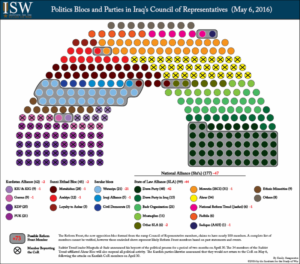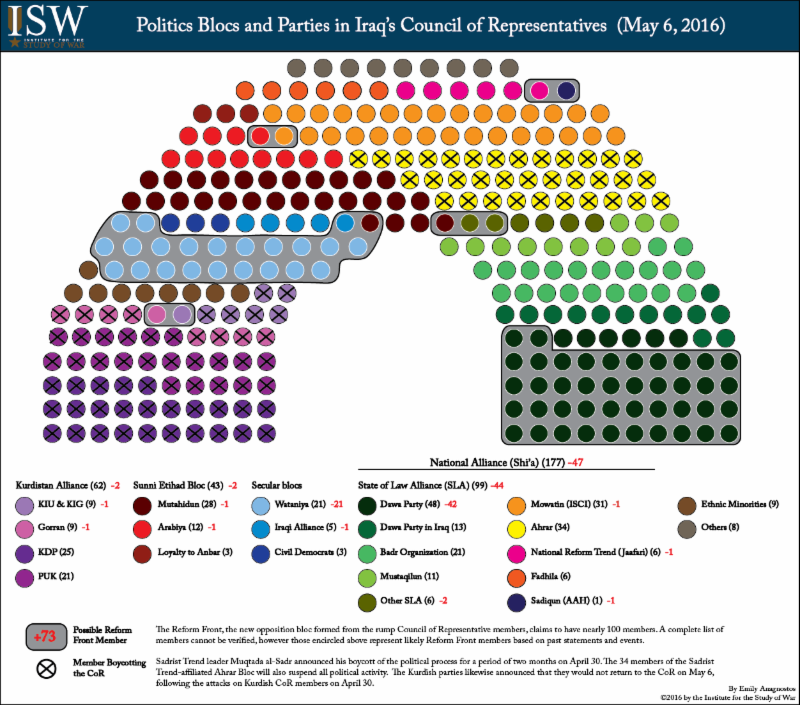
Iraq Council of Representatives Graphic
Iraq’s “rump” Council of Representatives (CoR) formed on April 14, 2016 when some members of Parliament staged a sit in after months of stalled reforms. The rump CoR, at its zenith, was supported by multiple prominent political parties, including the Sadrist al-Ahrar Bloc and the Badr Organization. These parties largely walked out of the rump CoR by April 20. The rump CoR could not reach a quorum as a result and failed to gain recognition as a legal entity. Most of its members have refocused their efforts on forming a new opposition bloc, the “Reform Front,” first reported on April 27. The Reform Front claims to have at least 98 members, consisting of 42 pro-Maliki Dawa Party members, all of the members from Iyad Allawi’s Wataniya Bloc, and an unverifiable number of members who defected from their parties. If the claim is accurate, then the Reform Front will become the largest bloc in the CoR, surpassing the State of Law Alliance which stands to lose substantial numbers to the Front.
The Reform Front is likely steered by former Prime Minister Nouri al-Maliki, though several members have denied his involvement. Maliki has contested Abadi’s leadership of the Dawa Party since he lost the premiership in 2014 amidst growing domestic and international pressure for political change. The recent resignation of Hassan al-Sinid on April 28, the placeholder for Maliki’s seat in the CoR during his tenure as Vice President, could indicate that Maliki looks to resume his seat in the CoR, an essential prerequisite for becoming Prime Minister. Maliki has denied the rumors of his return.
The largest bloc in Iraq’s parliament constitutionally has the right to select the Prime Minister and form the Council of Ministers after general elections or after a no-confidence vote in the Prime Minister. Maliki formed a government in 2010 even though he did not win the elections outright by creating a legal challenge about how to define the “largest bloc.” The Front’s emergence could facilitate Maliki’s return as prime minister if the parliament ousts Abadi.
The withdrawal of confidence from Abadi is also not likely imminent over the next few weeks barring an unexpected event that creates a further state of emergency. Many of Iraq’s political leaders are engaged in intense behind the scenes meetings to help break the deadlock without a vote of no-confidence. There is no clear coalition emerging within the CoR that can achieve an absolute majority of 165 members to vote no-confidence or select a successor. Anti-Maliki sentiment remains strong among elite politicians, undercutting the likelihood that he will be able to generate sufficient support for a no-confidence vote and government formation himself. The Reform Front’s tenuous position as a coalition of convenience may collapse. Both Maliki and Allawi seek power, and they cannot both have it.
Maliki, therefore, is most likely to try to ride the political wave by positioning himself as a potential unifier who can bridge the gap between the Reform Front and other blocs – a gap that he has helped create and maintain. He issued a statement on May 6 calling for all CoR blocs to reconvene a session to find a solution to the political crisis. He is likely to try to rally Abadi’s Dawa Party supporters to his side along with other consensus-minded political blocs while aligning temporarily with Allawi, his rival for the premiership in 2010, with the ultimate intent of acquiring the 165 votes necessary to achieve an absolute majority in the CoR. It is not even clear whether the CoR will even be able to resume sessions soon. It is next scheduled to meet on May 10, and it can only make decisions if a quorum of 165 members is reached. The 34 members of the Sadrist al-Ahrar Bloc, however, withdrew from the CoR on April 30 and at least 60 members of the Kurdistan Alliance agreed on May 6 to not return to the CoR. The absence of as many as 94 members will make it more difficult for Speaker Salim al-Juburi to achieve quorum. The Kurds have likely presented a set of political demands regarding the cabinet reshuffle and the size of their representation in government to other Shi’a parties as a condition for their return and may return to the CoR before the Sadrists if the other blocs agree to their demands. Other political blocs may also boycott the CoR, less ostentatiously, as the cabinet reshuffle drags on. Political impasse will therefore likely persist.
This graphic is an approximate depiction of the current state of the Council of Representatives. It shows the number and party affiliation of CoR members who have boycotted future parliamentary sessions. It also shows the number and party affiliation of CoR members whom ISW assesses may be part of the Reform Front based on the Reform Front’s unconfirmed claim that it is at least 98-members strong. The graphic demonstrates the tumultuous current state of the CoR and the difficulty for a session to achieve quorum.
Source: Institute for the Study of War (IWS). May 6, 2016








Comment here